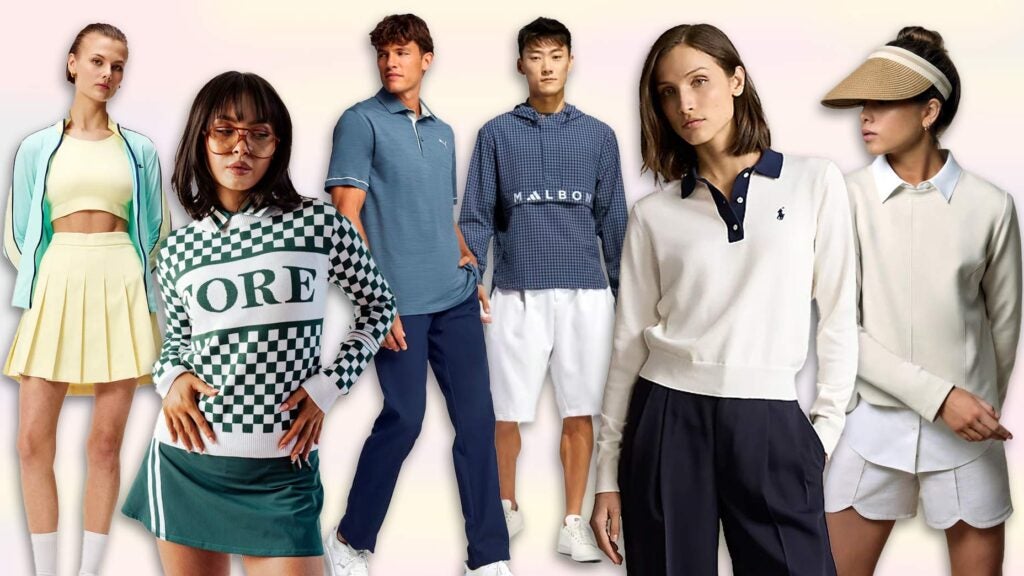Branded Clothing for Active Lifestyles: What Fabrics Support Performance?
Branded Clothing for Active Lifestyles: What Fabrics Support Performance?
Blog Article
The Relevance of Lasting Apparel: Exactly How It Affects the Atmosphere and Your Wardrobe
Sustainable clothes is increasingly identified for its vital function in minimizing the environmental influence of the fast apparel industry. By concentrating on environmentally friendly materials and honest production methods, it resolves pressing environmental issues. This shift not only benefits the planet however additionally affects consumer options, leading to a much more thoughtful technique to closet administration. Recognizing these characteristics elevates crucial concerns regarding fashion's future and individual duty fit it.
The Ecological Footprint of Fast Style

Advantages of Lasting Materials
Sustainable products supply considerable benefits, especially via eco-friendly textile options that decrease environmental harm. These products additionally demonstrate longevity and long life, reducing the demand for constant substitutes. Because of this, they add to a more lasting garment industry and advertise accountable consumer actions.
Eco-Friendly Textile Options
While the fashion industry has long been connected with rapid patterns and environmental damage, the rise of environmentally friendly material choices offers a transformative chance. Sustainable products such as organic cotton, hemp, and Tencel have actually gotten popularity as a result of their lower environmental impact. These textiles are often generated without dangerous pesticides and call for less water, reducing their carbon footprint - Branded Clothing. In addition, many green fabrics are naturally degradable, contributing to a round economic situation by reducing waste. Picking sustainable products not only supports eco responsible methods yet also promotes healthier ecological communities. As consumers come to be much more aware of their acquiring power, the demand for green fabrics encourages brands to introduce and take on even more lasting production techniques, inevitably profiting the planet and future generations
Durability and Long Life Advantages
Numerous customers are increasingly acknowledging the sturdiness and long life benefits of sustainable products in their garments selections. Unlike conventional fabrics, sustainable products such as organic cotton, hemp, and recycled polyester are crafted to endure wear and tear, causing garments that last longer. This minimized regularity of substitute not just conserves customers cash with time but likewise reduces waste generated by fast fashion. Additionally, sustainable clothing often employs environment-friendly manufacturing approaches that boost textile toughness, contributing to a reduction in the total carbon footprint. By spending in long lasting garments, customers can cultivate a more sustainable wardrobe while appreciating top quality items that maintain their visual and capability with time. Subsequently, durability and longevity stand as key advantages of selecting sustainable products.
Lowering Waste With Lasting Practices
Decreasing waste in the apparel industry can be achieved via ingenious practices such as upcycling and repurposing products. Furthermore, adopting minimal wardrobe approaches encourages customers to prioritize top quality over amount, ultimately lowering garments consumption. With each other, these strategies contribute substantially to a much more lasting clothing version.
Upcycling and Repurposing Materials
Upcycling and repurposing products have actually emerged as cutting-edge techniques in the style industry, changing discarded fabrics right into important brand-new products. This technique not only reduces waste however also urges imagination and originality in apparel design. By taking old garments and products, designers can develop unique pieces that show individual design while reducing the need for new resources. In addition, upcycling usually needs much less energy and water compared to standard manufacturing processes, substantially lowering the environmental footprint of fashion. As customers come to be much more mindful of sustainability, the popularity of upcycled apparel remains to rise, promoting a circular economic climate. Eventually, these practices add to a more sustainable future, where fashion focuses on ecological health over quick manufacturing and intake.

Minimal Closet Approaches
As individuals significantly look for to decrease their ecological influence, taking on minimal closet methods has actually gotten grip as an effective approach to sustainable style. These approaches stress top quality over amount, encouraging consumers to curate a smaller collection of versatile, durable clothing. By focusing on classic items that can be blended and matched, individuals can decrease the frequency of acquisitions and eventually decrease waste.Additionally, minimalism advertises conscious consumption, urging customers to review the environmental and moral effects of their options. This approach not just promotes a more lasting way of life but also streamlines everyday decision-making pertaining to outfit. As people welcome minimalist concepts, they contribute like this to a style society that values sustainability and responsible consumerism, eventually resulting in a more eco-conscious society.
The Role of Moral Labor in Lasting Style
While many consumers are increasingly mindful of the environmental repercussions of their garments options, the importance of honest labor techniques in sustainable fashion can not be ignored. Moral labor encompasses reasonable incomes, risk-free working problems, and respect for employees' legal rights, creating the backbone of liable fashion production. Brand names that prioritize moral labor not just uplift areas but likewise established a requirement for liability in the industry.Moreover, the combination of honest practices promotes openness, enabling customers to make informed choices concerning their acquisitions. This practice contrasts greatly with quick style's exploitative labor versions, which typically focus on profit over people. By sustaining firms committed to honest labor, customers add to a system that values human dignity alongside environmental sustainability. Subsequently, moral labor is not just an add-on; it is important to the more comprehensive goal of sustainable fashion, guaranteeing that the mission for eco-friendliness does not come with the expenditure of human civil liberties.
The Effect of Sustainable Apparel on Carbon Emissions
Lasting clothes has the potential to considerably decrease carbon emissions related to the fashion business. Standard garment production adds see this page especially to greenhouse gas discharges, primarily as a result of energy-intensive production processes and the use of non-renewable sources. In comparison, sustainable style concentrates on environmentally friendly products, such as natural cotton or recycled fibers, which commonly need less energy to produce.Moreover, lasting brands tend to embrace extra effective manufacturing techniques, lessening waste and lowering total exhausts. By focusing on toughness and timeless layout, sustainable clothing motivates consumers to get less often, more minimizing the carbon impact associated with overconsumption.Additionally, several sustainable brand names are committed to openness in their supply chains, enabling consumers to make educated options that straighten with their values. Ultimately, moving towards sustainable clothing can lead to a considerable decrease in carbon emissions, adding to a much healthier planet and a more sustainable future for the apparel industry.
Supporting Neighborhood Economic Climates With Sustainable Selections
The shift toward lasting clothes not only addresses ecological concerns however additionally considerably benefits regional economic situations. By picking sustainable fashion, consumers commonly sustain neighborhood artisans and small companies, boosting community resilience. These business commonly operate on a smaller scale, prioritizing craftsmanship and honest techniques over mass production.Investing in locally made lasting clothing promotes work creation and stimulates economic growth within neighborhoods. As consumers end up being much more knowledgeable about the ecological effect of their acquisitions, they increasingly seek out products that reflect their values. This demand encourages local producers to embrace lasting practices, adding to a round economy.Moreover, sustaining regional services lowers transport discharges, lining up with eco-conscious consumer actions. The interconnectedness of lasting garments and regional economic climates highlights the crucial duty that private choices play in promoting both economic and ecological health and wellness. By fostering these local links, communities can thrive while additionally working in the direction of an extra lasting future.
Transforming Your Storage Room: Tips for a Sustainable Wardrobe
As people seek to lower their ecological effect, transforming a storage room right into a sustainable closet ends up being a crucial action. One efficient strategy is to assess existing apparel, keeping just products that are used frequently which line up with sustainability objectives. Focusing on quality over amount is important; investing in resilient pieces from green brands can substantially decrease waste.Additionally, incorporating second-hand items can breathe new life into a closet while minimizing ecological damages. Organizing clothing swaps with good friends or contributing extra things can further advertise sustainability.When shopping, individuals must seek products that are organic, recycled, or eco-friendly, and stay clear of quick fashion stores - Branded Clothing. Practicing conscious intake by attentively considering each purchase can contribute to a more sustainable way of life. By carrying out these pointers, one can develop a wardrobe that reflects personal style while supporting environmental stewardship
Often Asked Concerns
Exactly How Can I Determine Lasting Apparel Brands?
To recognize lasting clothing brands, one should research materials utilized, look for qualifications like Fair Profession, and examine the brand's openness concerning their manufacturing procedures, labor methods, and ecological effect, making sure moral and eco-friendly practices are prioritized.
What Are the Costs Connected With Lasting Fashion?
The costs connected with sustainable style can differ substantially. Greater production expenses, ethical sourcing, and eco-friendly products typically cause enhanced retail rates, which might prevent some customers while attracting eco aware buyers.
Can Lasting Clothes Be Trendy and elegant?
Sustainable garments can undoubtedly be stylish and trendy. Designers increasingly prioritize innovative products and moral production techniques, showing that style and sustainability can exist together. Customers now have diverse options that mix looks with environmental awareness.
Exactly How Does Washing Clothes Affect Their Sustainability?
Cleaning garments substantially effects sustainability by consuming water and energy, adding to pollution, and causing microplastic release. Constant washing can weaken textiles, reducing their life expectancy and raising the demand for replacements, inevitably exacerbating environmental issues.
What Is the Life Expectancy of Sustainable Apparel Compared to Fast Style?
The life over here expectancy of sustainable clothes commonly surpasses that of fast style items, often lasting numerous years as a result of top quality products and workmanship. In contrast, fast fashion garments may weaken rapidly, demanding even more frequent substitutes. Lasting clothes is significantly identified for its critical function in decreasing the environmental effect of the rapid fashion industry. While many customers are significantly mindful of the ecological effects of their clothing choices, the relevance of honest labor techniques in lasting style can not be forgotten. Branded Clothing. Lasting clothing has the potential to significantly decrease carbon emissions linked with the style market. In comparison, sustainable fashion concentrates on environment-friendly products, such as organic cotton or recycled fibers, which usually call for much less energy to produce.Moreover, sustainable brands often tend to take on extra reliable production methods, reducing waste and decreasing total discharges. By prioritizing resilience and classic layout, sustainable clothing urges consumers to get less often, additional minimizing the carbon footprint connected with overconsumption.Additionally, numerous lasting brands are committed to openness in their supply chains, making it possible for consumers to make informed selections that line up with their values
Report this page